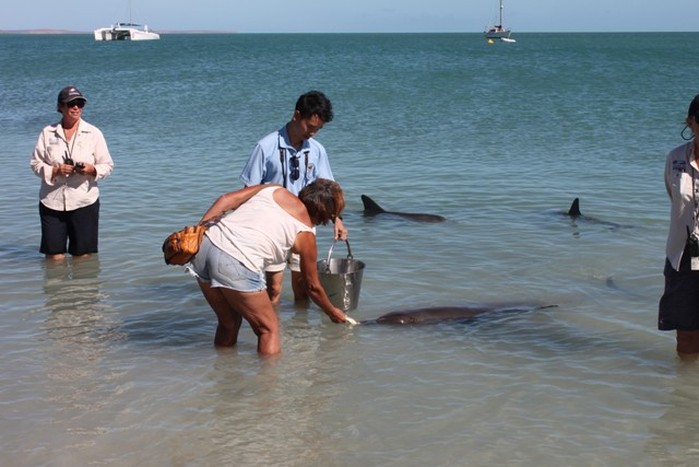
ABOVE: Nancy feeds “Mommy Dearest” Nicky as Lia watches at left.
Naughty Nicky is the Joan Crawford of the dolphin world: internationally famous but a lousy mother.
So confided Lia the Kiwi dolphin handler at Monkey Mia as she warned that the road to the western-most point of the Australian mainland was the worst she had ever travelled.
We stopped into Monkey Mia to do the tourist thing on our way to Steep Point. Having been to Cape York in the north we thought we would drive as far as we could west, stopping to do the dolphin touristy thing on the way. I suspect Tin Can Bay's wild dolphin experience near home is as good but when in Shark Bay do what the tourists do.
Tip: If you are not keen on caravan parks, call up the Denham information centre and book a site at one of the coastal national parks camping sites first. The sites are cheap and picturesque but if you don’t book first you need to backtrack about 40km after getting into Denham, a rather pretty, pleasant town on the other side of the peninsula from Monkey Mia.
Denham is worth visiting so you can have a beer in Australia’s most western pub, the Shark Bay Hotel. Realising we would have to go back quite aways to the parks campsite we rather reluctantly booked into a caravan park taking consolation from the fact that we could have a wee night out at the pub.
Barry the park manager, who had just returned with his wife from a game of golf on an extraordinary course, shook his head when we told him we were going to Steep Point. The road was really rough, he warned, and the rogue waves out there ….. well, two locals had been a fair way back from the edge of the cliff last year when a wave reared out of nowhere and grabbed then, throwing them to the ground and breaking bones.
Early the next morning we headed across to Monkey Mia, passing the weird golf course in the parched landscape. The tees were artificial turf on concrete; the greens were black synthetic. We made sure we were at the dolphin rendezvous (cost about $16 each) before starting time at 7.45am but oodles of tourists, mainly foreigners, beat us there. We were told the five feeding dolphins were allowed three feeds of 500g each morning. It was up to them when they dined.
The first pod came in pretty much on cue. Thousands of Indo-Pacific bottlenose dolphins are in Shark Bay, living uneasily with 28 species of shark in the 4000 sq km of seagrass fields that host decent dugong numbers. God knows how lonely seamen ever mistook the lumpy dugongs for lovely mermaids but they are one of the reasons the bay is World Heritage listed. Shark Bay can boast to being the only place in the world that meets all the criteria for listing.
No one knows how the Monkey got into Mia (an Aboriginal word for “place”) but the fishing village became famous when a fishermen’s wife started feeding a few spare fish to some of the dolphins that followed her husband’s boat home in the 1960s.
Dolphin feeding grew as the tourist potential was realised and businesses cashed in. That led to a generation of little dolphins virtually cashing their chips because their mums forgot how to fish for themselves, never taught the kids and never looked after the kids properly.
National Parks moved in to bring in controlled feeding that would persuade the dolphins to live a respectable dolphin life instead of bludging and neglecting the kids. Dolphins live a bit like humans – eight hours sleep, eight hours work (hunting fish) and eight hours play. Unlike us, they can swim at 40kph, waggle their eyes independently and see equally well above and below the water.
Like us, they can be lazy if someone else can be persuaded to do the work. Nicky – named for her dorsal fin nick – is close to 40 but still can’t really look after herself. With her hand-fed rations cut down to a strict 1.5kg of the 10 to 20kg that she needs, she is forced to find the rest of her daily fish from the sea but instead of hunting she begs from fishing boats everywhere.
Not one of her eight calves has made it to adulthood. Little Nipper, Finnick, Nakita, Holikin, Nomad, Yadgalah and Yule have all disappeared. Possibly they starved to death because mummy couldn’t teach them to stand on their own flippers. A more likely explanation is that mummy was so obsessed with begging that she didn’t keep careful watch on her babies and nudge them back when they swam into the deep water in channels where one of the 28 species of sharks wait to pounce on straying dolphin calves.
No. 8, Fin, might make it. The dolphin rangers have high hopes because she has become pals with another female who might teach her how to be a real dolphin.
Meanwhile Nicky basks in fame as the most photographed wild dolphin in the world, a la Mommy Dearest.
Lia, from Auckland, was an excellent host at Monkey Mia and tried to be diplomatic about Nicky’s shortcomings, searching for a dolphin description for bad mother. She couldn’t come up with one.
We watched the first feeding. I had heard that some of the early crowd pings off after that and it can be easier to be invited to feed a dolphin in the second and third sitting. Bingo. I smiled hopefully at the chap holding the fish bucket, he beckoned and I fed the naughty Nicky a fish.
Lia has hankered to be a dolphin guide at Monkey Mia since 1980s. She made it to Shark Bay a couple of years ago and worked in the resort for a year before being accepted as a ranger.
She told us another horror story about the winds and rogue waves at Steep Point. A year ago six blokes were fishing on the cliff with two spotters. A king wave unseen by the spotters swept the six off the cliff. One died; the others were in the water about four hours until rescued by helicopter.
We headed for Steep Point. I secretly hoped to see a king wave. From a distance.
Naughty Nicky is the Joan Crawford of the dolphin world: internationally famous but a lousy mother.
So confided Lia the Kiwi dolphin handler at Monkey Mia as she warned that the road to the western-most point of the Australian mainland was the worst she had ever travelled.
We stopped into Monkey Mia to do the tourist thing on our way to Steep Point. Having been to Cape York in the north we thought we would drive as far as we could west, stopping to do the dolphin touristy thing on the way. I suspect Tin Can Bay's wild dolphin experience near home is as good but when in Shark Bay do what the tourists do.
Tip: If you are not keen on caravan parks, call up the Denham information centre and book a site at one of the coastal national parks camping sites first. The sites are cheap and picturesque but if you don’t book first you need to backtrack about 40km after getting into Denham, a rather pretty, pleasant town on the other side of the peninsula from Monkey Mia.
Denham is worth visiting so you can have a beer in Australia’s most western pub, the Shark Bay Hotel. Realising we would have to go back quite aways to the parks campsite we rather reluctantly booked into a caravan park taking consolation from the fact that we could have a wee night out at the pub.
Barry the park manager, who had just returned with his wife from a game of golf on an extraordinary course, shook his head when we told him we were going to Steep Point. The road was really rough, he warned, and the rogue waves out there ….. well, two locals had been a fair way back from the edge of the cliff last year when a wave reared out of nowhere and grabbed then, throwing them to the ground and breaking bones.
Early the next morning we headed across to Monkey Mia, passing the weird golf course in the parched landscape. The tees were artificial turf on concrete; the greens were black synthetic. We made sure we were at the dolphin rendezvous (cost about $16 each) before starting time at 7.45am but oodles of tourists, mainly foreigners, beat us there. We were told the five feeding dolphins were allowed three feeds of 500g each morning. It was up to them when they dined.
The first pod came in pretty much on cue. Thousands of Indo-Pacific bottlenose dolphins are in Shark Bay, living uneasily with 28 species of shark in the 4000 sq km of seagrass fields that host decent dugong numbers. God knows how lonely seamen ever mistook the lumpy dugongs for lovely mermaids but they are one of the reasons the bay is World Heritage listed. Shark Bay can boast to being the only place in the world that meets all the criteria for listing.
No one knows how the Monkey got into Mia (an Aboriginal word for “place”) but the fishing village became famous when a fishermen’s wife started feeding a few spare fish to some of the dolphins that followed her husband’s boat home in the 1960s.
Dolphin feeding grew as the tourist potential was realised and businesses cashed in. That led to a generation of little dolphins virtually cashing their chips because their mums forgot how to fish for themselves, never taught the kids and never looked after the kids properly.
National Parks moved in to bring in controlled feeding that would persuade the dolphins to live a respectable dolphin life instead of bludging and neglecting the kids. Dolphins live a bit like humans – eight hours sleep, eight hours work (hunting fish) and eight hours play. Unlike us, they can swim at 40kph, waggle their eyes independently and see equally well above and below the water.
Like us, they can be lazy if someone else can be persuaded to do the work. Nicky – named for her dorsal fin nick – is close to 40 but still can’t really look after herself. With her hand-fed rations cut down to a strict 1.5kg of the 10 to 20kg that she needs, she is forced to find the rest of her daily fish from the sea but instead of hunting she begs from fishing boats everywhere.
Not one of her eight calves has made it to adulthood. Little Nipper, Finnick, Nakita, Holikin, Nomad, Yadgalah and Yule have all disappeared. Possibly they starved to death because mummy couldn’t teach them to stand on their own flippers. A more likely explanation is that mummy was so obsessed with begging that she didn’t keep careful watch on her babies and nudge them back when they swam into the deep water in channels where one of the 28 species of sharks wait to pounce on straying dolphin calves.
No. 8, Fin, might make it. The dolphin rangers have high hopes because she has become pals with another female who might teach her how to be a real dolphin.
Meanwhile Nicky basks in fame as the most photographed wild dolphin in the world, a la Mommy Dearest.
Lia, from Auckland, was an excellent host at Monkey Mia and tried to be diplomatic about Nicky’s shortcomings, searching for a dolphin description for bad mother. She couldn’t come up with one.
We watched the first feeding. I had heard that some of the early crowd pings off after that and it can be easier to be invited to feed a dolphin in the second and third sitting. Bingo. I smiled hopefully at the chap holding the fish bucket, he beckoned and I fed the naughty Nicky a fish.
Lia has hankered to be a dolphin guide at Monkey Mia since 1980s. She made it to Shark Bay a couple of years ago and worked in the resort for a year before being accepted as a ranger.
She told us another horror story about the winds and rogue waves at Steep Point. A year ago six blokes were fishing on the cliff with two spotters. A king wave unseen by the spotters swept the six off the cliff. One died; the others were in the water about four hours until rescued by helicopter.
We headed for Steep Point. I secretly hoped to see a king wave. From a distance.
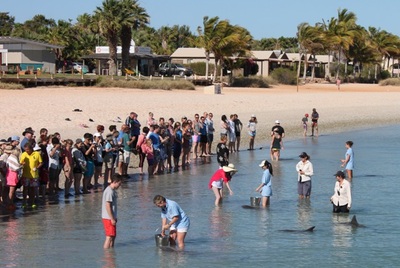
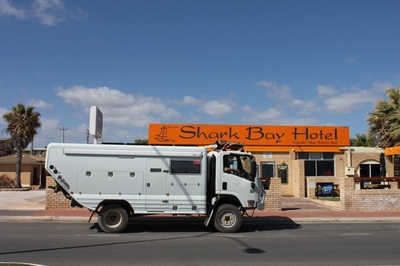
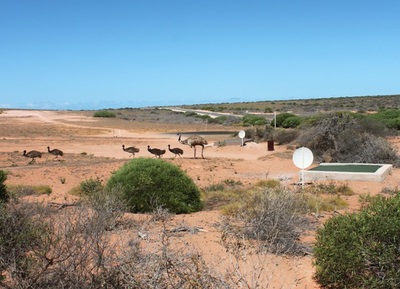
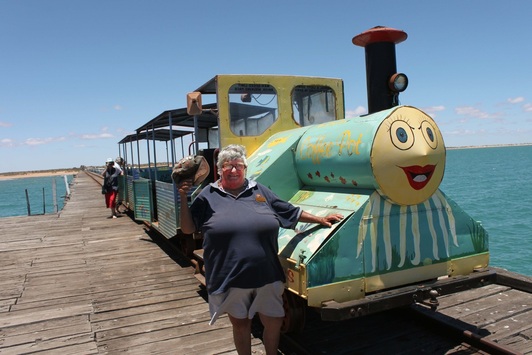
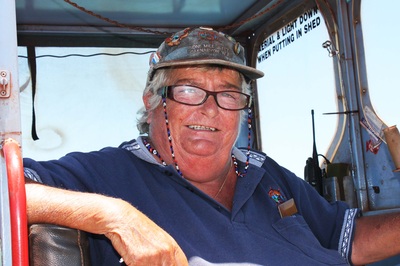
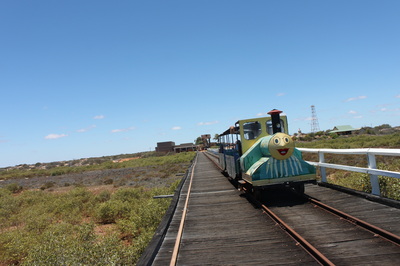
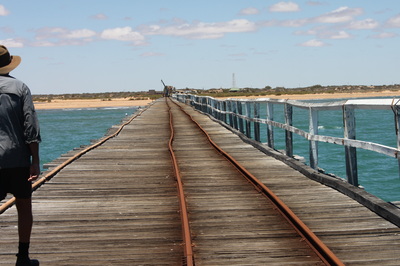
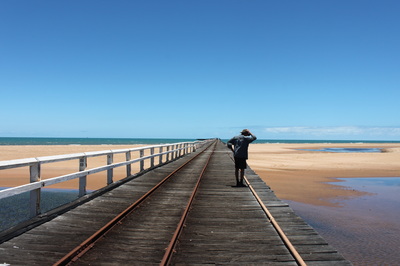
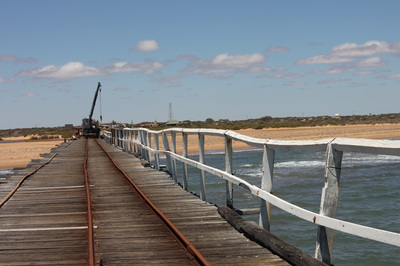
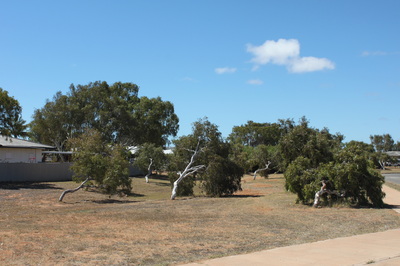
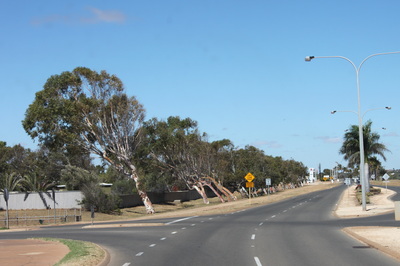
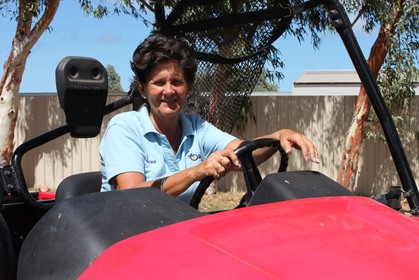
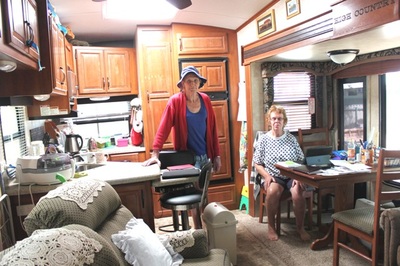
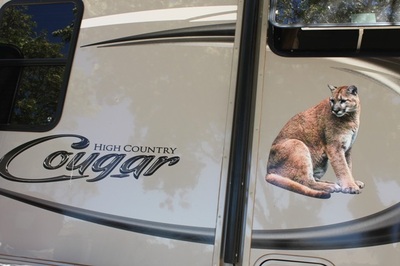
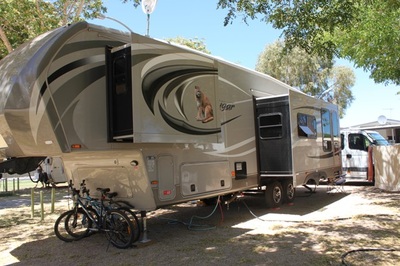
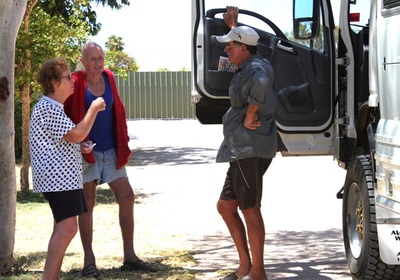
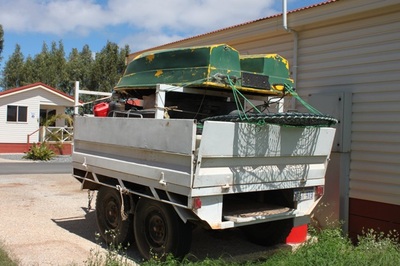
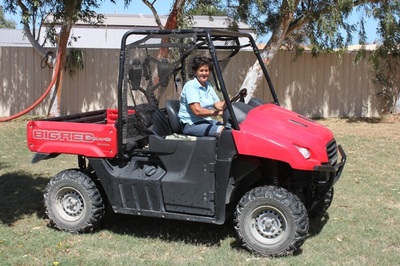
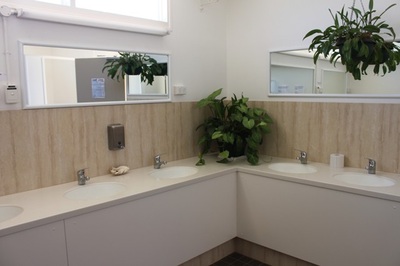
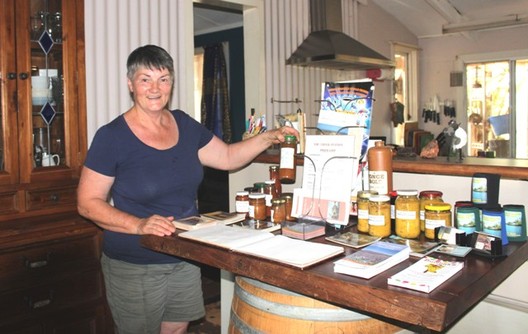
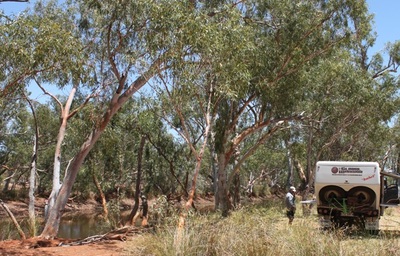
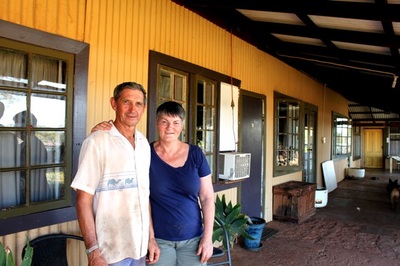
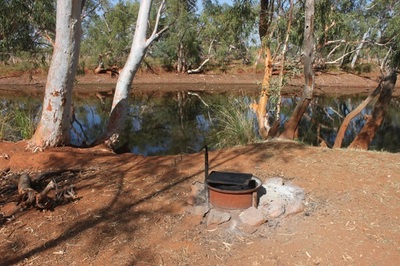
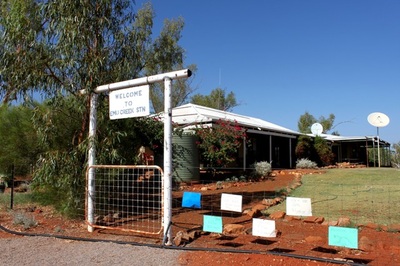

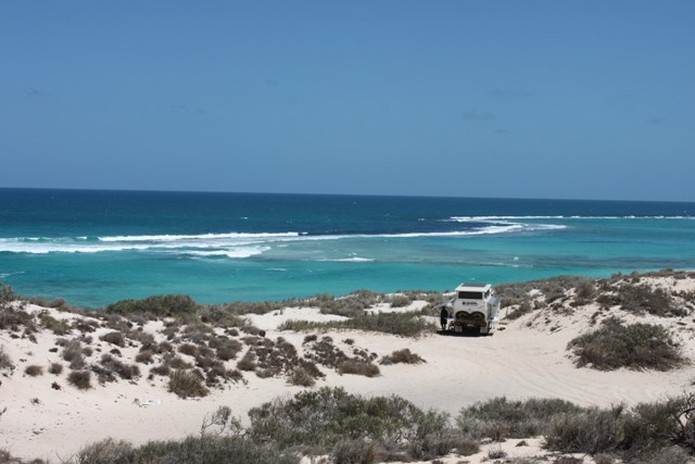
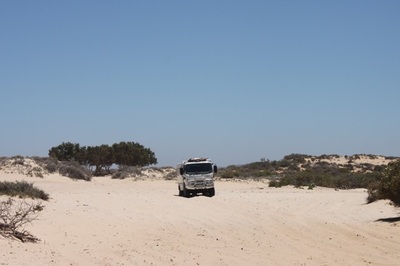
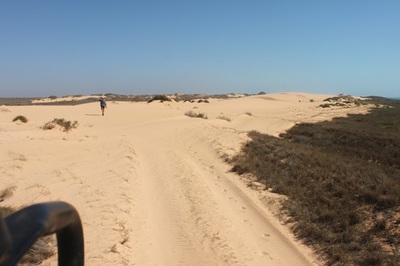
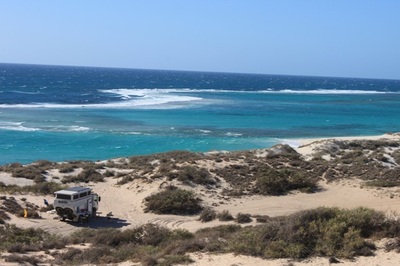
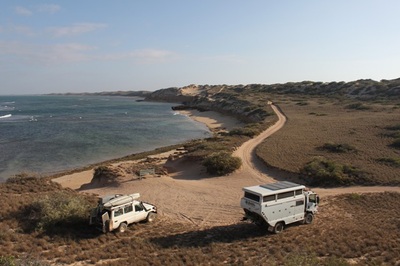
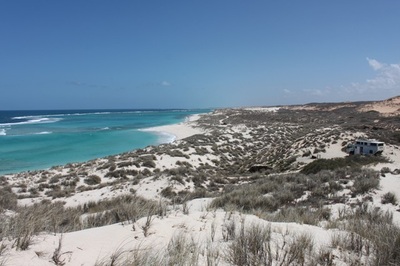
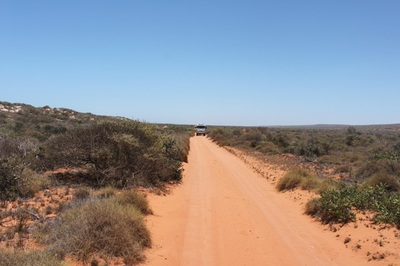
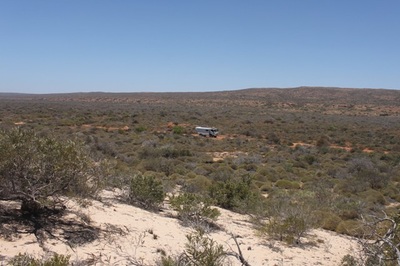
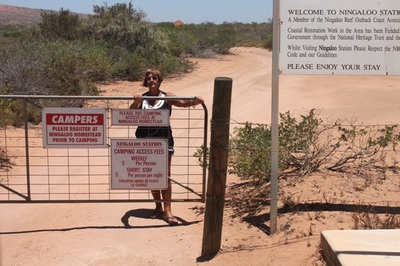
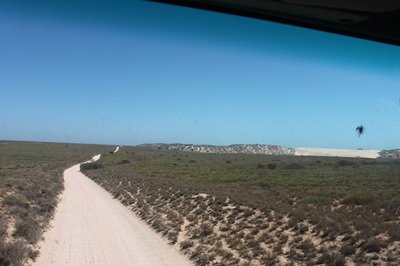
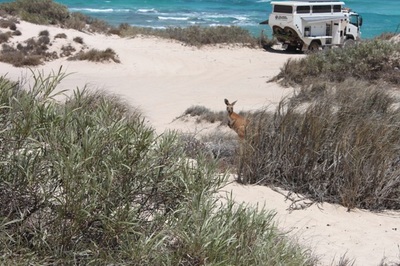
 RSS Feed
RSS Feed
